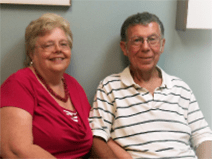The Challenge
Sixty-three-year-old retired steel mill worker Earl Smalley, Jr. had always been an active and vibrant person throughout his life. But nearly four years ago, Earl’s personality and appearance began to drastically change.
"I felt really good, pretty much right away, and got my personality back." — Earl
The change was progressive, yet very gradual. He began to gain weight and suffer from depression symptoms, including low energy and a lack of concern for his appearance and well-being. Rhonda, his wife of 39 years, believed something was seriously wrong.
"Earl wasn’t himself anymore. He would just sit around all day and not do or say anything,” she said. “He gained about 150 pounds, and wasn’t able to hold a conversation anymore, I knew something wasn’t right."
Seeking a cause for Earl’s growing list of symptoms, the Smalleys visited a local doctor. Initially, Earl was diagnosed with depression and given medication to combat his symptoms. However, the medication failed and his health problems continued. A visit with another local doctor finally provided the Smalleys with answers, although not the kind they had hoped for. An MRI revealed a large, apple-sized meningioma (a tumor of the protective lining of the brain) that was causing increased pressure within his skull – the culprit behind Earl’s symptoms. If the tumor wasn’t removed, it would continue to grow, increasing Earl’s symptoms and ultimately causing severe damage to his brain.
Schedule an Appointment or Ask a Question
The Path to UPMC
After hearing the diagnosis, Earl and Rhonda’s son – a paramedic in the Pittsburgh area – made sure he was referred to the experts at UPMC. Dr. Robert Friedlander, Chairman of the Department of Neurosurgery, reviewed the MRI scans of Earl’s brain and made a call to the Smalleys with some good news.
“Dr. Friedlander called and said he’d be able to help and get me out of my slump,” said Earl. “After years of not being able to act like my normal self, and my wife doing all the housework, I knew it was time to get help.”
Within a week of speaking to Dr. Friedlander, Earl was scheduled for surgery.
The Solution
Because of the location and size of the tumor, Dr. Friedlander and a team of UPMC neurosurgeons used an advanced surgical approach to reach and remove the tumor.
Rhonda says, "We couldn't ask for a better surgical team. Dr. Friedlander, all the nurses and other staff, they were just great. It felt like they were going the extra mile for Earl, but after being there and talking to other patients, they do this for everyone. It’s just amazing.”
The Results
Almost immediately following the surgery, Earl’s health began to improve and his symptoms that he dealt with for four years were gone.
“I felt really good, pretty much right away, and got my personality back,” said Earl with a smile. “I lost close to 125 pounds so far, and I even put in a 24-foot swimming pool and a fence in our backyard. Now, I really enjoy an evening swim, and sometimes don’t know when to shut up.”
But the person most grateful for Earl’s recovery is definitely Rhonda.
“Before the surgery, I had to become a plumber, mechanic, landscaper, you name it,” she said. “He wouldn’t do anything, and it was making me exhausted. Now, he’s doing all those things and more. I can’t even name all the things he’s done around the house since the surgery, too many to count.”
Our patient stories profile a number of patients who have had minimally invasive brain surgery at UPMC. Although everyone's care experience is unique, we hope that sharing these stories will help other prospective patients and their families better understand these procedures and their potential benefits.
Earl's treatment and results may not be representative of all similar cases.
















